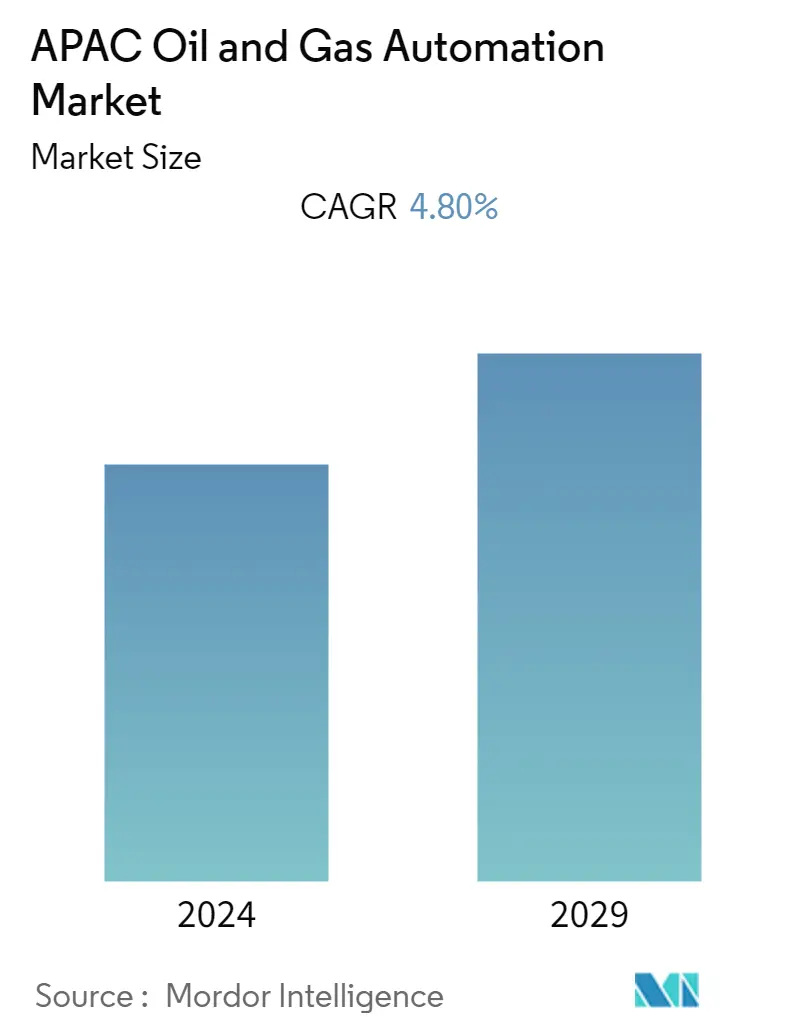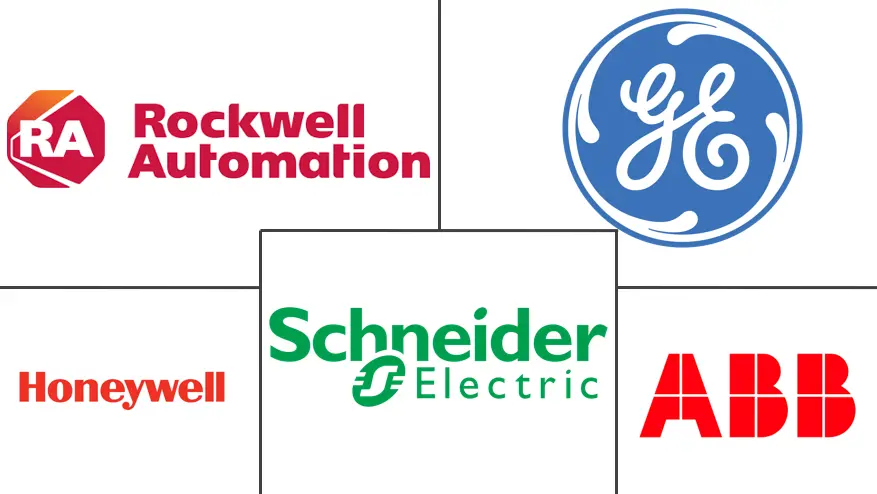Market Size of APAC Oil & Gas Automation Industry

| Study Period | 2019 - 2029 |
| Base Year For Estimation | 2023 |
| Forecast Data Period | 2024 - 2029 |
| Historical Data Period | 2019 - 2022 |
| CAGR | 4.80 % |
| Market Concentration | Medium |
Major Players
*Disclaimer: Major Players sorted in no particular order |
APAC Oil Gas Automation Market Analysis
The Asia Pacific Oil and Gas Automation Market was valued at USD 14.9 billion in 2020 and is expected to reach USD 19 billion by 2026, at a CAGR of 4.8% over 2021 - 2026. In the oil and gas industry processes, there is always a high demand for safety and reliability. The supply chain of this industry creates a great need for automation, industry expertise, and an extensive partner network. Process automation helps oil and gas producers integrate information, control, power, and provide safety solutions to respond to the dynamic global demand.
- Automation is being adopted across several industries to make an immediate and lasting difference, particularly in a large industry like the oil and gas sector. The oil & gas industry has begun the move toward digitization with more sensors accumulating data from rigs worldwide. However, there are still some untapped areas where companies can improve within an increasingly diverse market. Employing digital technologies can help engineering teams work more efficiently with oil and gas companies to manage data and project requirements better, improving internal communications and simplifying planning.
- Furthermore, in countries like India, there is a severe need to double the country's refining potential by 2040 to suffice growing fuel demand as passenger vehicles increase. However, downstream companies such as BP (India) have no plans to build new refineries despite growing oil production. They are expected to focus on modernizing existing plants while expanding their network of filling stations to generate USD 3 billion in additional cash.
- Declining sensor costs could also offer several cost-cutting measures to implement automation technologies in the oil & gas industry to improve productivity and eliminate any possible hindrances in the business model.
- However, according to the Digital-Re-Definery report released in the past year, the number of refiners that reported digital technologies delivering a margin improvement of more than 10% in refining operations dropped from 11% to 3%. The numbers also dropped for all subsequent margin improvement ranges. This underscores the fact that there is considerable potential for improvement as Oil and Gas Refineries are yet to capitalize ultimately on digital investments.
- Additionally, the oil & gas industry is suffering from a skilled labor shortage. The shallow talent pool has made it complicated for oil & gas companies to hire new employees with the technical skills required to work on new energy sources. Moreover, stress with the oil prices declining over 2020, in the wake of COVID-19 & price war between Saudi Arabi and Russia, is expected to drive the oil-producing companies to improve their production efficiency and dive the demand in the sector.
APAC Oil Gas Automation Industry Segmentation
Oil and gas, a dynamic global industry, often faces challenges in cost management, extraction of high value from current assets, and maximization of the up-time. Advancement in technology has led to a connected enterprise, which helps the oil and gas industry to move closer to operational excellence. Cloud, mobility, and analytics offer an actionable view into real-time production data.
| By Automation Technologies | |
| Distributed Control Systems (DCS) | |
| Programmable Logic Controller (PLC) | |
| Human Machine Interface (HMI) | |
| Supervisory Control and Data Acquisition (SCADA) | |
| Real Time Optimization & Simulation (RTOS) | |
| Others |
| By Sectors | |
| Upstream | |
| Midstream | |
| Downstream |
| By Petroleum Derivative Products | |
| Liquefied Petroleum Gas | |
| Petrol | |
| Diesel | |
| Others |
| By Geography | ||||||
|
APAC Oil & Gas Automation Market Size Summary
The Asia Pacific oil and gas automation market is experiencing a transformative phase driven by the need for enhanced safety, reliability, and efficiency in industry processes. As the sector increasingly adopts digital technologies, automation plays a crucial role in integrating information, control, and safety solutions to meet global demand. The market is characterized by a high penetration of automation in the downstream sector, where asset efficiency is vital for return on investment. Despite challenges such as a skilled labor shortage and the need for significant capital investment in new technologies, the industry is poised for growth as companies focus on modernizing existing infrastructure and expanding their networks. The adoption of IoT solutions, predictive maintenance systems, and advanced analytics is expected to drive productivity and efficiency, particularly in countries like India, where refining capacity needs to be enhanced to meet rising fuel demand.
The competitive landscape of the Asia Pacific oil and gas automation market is dominated by major players who are expanding their global presence through strategic collaborations and acquisitions. These companies are leveraging partnerships to enhance their product offerings and increase market share. Notable collaborations, such as those between Emerson and Quantum Reservoir Impact, and Automation Anywhere with Indian Oil Corporation Limited, highlight the industry's focus on integrating AI-based analytics and robotic process automation to drive innovation. The market is also witnessing advancements in sensor technology and cloud-based data analytics, which are essential for optimizing operations and reducing environmental impact. As the industry continues to evolve, automation technologies are expected to play a pivotal role in maintaining high production output and improving operational efficiencies.
APAC Oil & Gas Automation Market Size - Table of Contents
-
1. MARKET DYNAMICS AND TRENDS
-
1.1 Market Overview
-
1.2 Factors Driving the Market
-
1.2.1 Optimizing Production
-
1.2.2 Enhancing Safety and Security
-
1.2.3 Effective and Easy Maintenance
-
1.2.4 Exploration from Aging Reservoirs
-
-
1.3 Factors Restraining the Market
-
1.3.1 Initial Investment is high
-
1.3.2 Political Instability
-
-
1.4 Current Opportunities in the Market
-
1.5 Technology Snapshot
-
1.6 Porters Five Forces Analysis
-
1.6.1 Bargaining Power of Suppliers
-
1.6.2 Bargaining Power of Consumers
-
1.6.3 Threat of New Entrants
-
1.6.4 Threat of Substitute Products and Services
-
1.6.5 Competitive Rivalry within the Industry
-
-
1.7 Industry Value-Chain Analysis
-
1.8 Industry Policies
-
-
2. MARKET SEGMENTATION
-
2.1 By Automation Technologies
-
2.1.1 Distributed Control Systems (DCS)
-
2.1.2 Programmable Logic Controller (PLC)
-
2.1.3 Human Machine Interface (HMI)
-
2.1.4 Supervisory Control and Data Acquisition (SCADA)
-
2.1.5 Real Time Optimization & Simulation (RTOS)
-
2.1.6 Others
-
-
2.2 By Sectors
-
2.2.1 Upstream
-
2.2.2 Midstream
-
2.2.3 Downstream
-
-
2.3 By Petroleum Derivative Products
-
2.3.1 Liquefied Petroleum Gas
-
2.3.2 Petrol
-
2.3.3 Diesel
-
2.3.4 Others
-
-
2.4 By Geography
-
2.4.1 Asia Pacific
-
2.4.1.1 China
-
2.4.1.2 India
-
2.4.1.3 Japan
-
2.4.1.4 Others
-
-
-
APAC Oil & Gas Automation Market Size FAQs
What is the current APAC Oil & Gas Automation Market size?
The APAC Oil & Gas Automation Market is projected to register a CAGR of 4.80% during the forecast period (2024-2029)
Who are the key players in APAC Oil & Gas Automation Market?
ABB Ltd, Honeywell International Inc., General Electric Company, Rockwell Automation and Schneider Electric SE are the major companies operating in the APAC Oil & Gas Automation Market.

